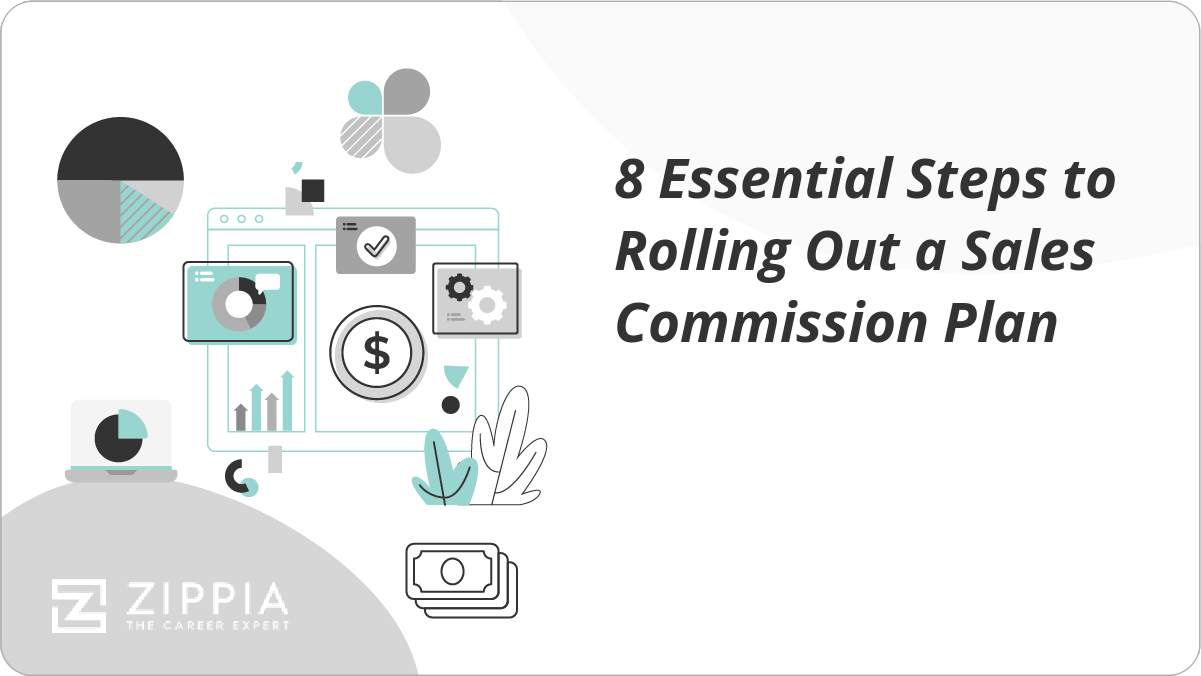In every well-managed organization, sales commission plans change regularly. To outsiders, this is often surprising. Why, the finance person wonders, is it that we need yet another new sales commission plan this year?
The reality is that commission plans must change to reflect new business priorities. In any good business, although the mission and vision are (ideally) constant, the initiatives undertaken to fulfill that vision are not.
If a business intends to execute three new strategic initiatives in the new financial year, does it really make sense to retain the commission plan that was built around last year’s goals?
If, for whatever reason, you should find yourself in a position to have to restructure your incentive, commission, or bonus plan (call it what you will) the questions become:
-
How do you make sure that you get the plan right?
-
How do you ensure an effective rollout?
In this article, you’ll find eight essential steps for rolling out a sales commission plan that will help make this process go more smoothly.
Key Takeaways
-
Overcommunicate to avoid surprising your employees with a new sales commission plan.
-
Get the input of your top salespeople as well as your leaders when creating a sales commission plan.
-
Test your commission plan before implementing it.

How To Roll Out a Sales Commission Plan
-
Set Expectations Well in Advance
The single most critical component of an effective plan rollout is communication.
Ideally, at least one quarter (if not six months) before the plan changes, everyone on the sales team knows that changes to their commission plan are being evaluated.
When you communicate that changes are coming, you should be clear on a) why the plan is changing; and b) what the key behaviors are that you want to reward moving forward. If done successfully, there won’t be any surprises when the new sales plan is shared with the team.
-
Build a Roundtable
When designing a commission structure or even just brainstorming ideas it’s easy to fall into the trap of allocating all of your time to decision-makers (VP of Sales, CFO) and financial models. This is a great way to design a plan that underutilizes or completely ignores the collective wisdom of your sales team.
To tap into that knowledge, you should recruit a small group of top-performing salespeople and assemble them into a feedback roundtable. This becomes a great source of ideas and feedback.
Perhaps most importantly, when it is time to roll out the plan, this group will become the plan’s biggest cheerleaders, as the new commission structure is something they genuinely helped create.
-
Identify Potential Plans
With a feedback group in place, it’s time to winnow down the commission plan options from a universe of possibilities to just a handful of options, ideally no more than three.
Getting to that list shouldn’t be hard; lay out the strategic priorities for the business over the next year and cross-reference them against the initial suggestions you’ve received from the roundtable, it should be clear to you what your best options are.
At this time, it’s also appropriate to float those ideas by the people who will eventually have to sign off on the plan including the CFO, SVP of Sales, and potentially the CEO.
There is no point in running the numbers or sharing these options with a feedback group if the top-level executives aren’t on board at the concept phase.
-
Backtest, Backtest, Backtest!
Once you have finalized a few potential commission plans, you then need to decide what quotas you want to set; what the accelerators should be; and how most reps would fare under the new system.
To answer these questions effectively, you’ll need to set up a financial model for each of the plans you’re considering.
The model should tell you not only what any rep would earn under some hypothetical attainment level, but what they would have earned during any previous period, going back about (ideally) as long as each rep has been working at the company.
The results of that analysis should be compared against each other as well as historical actuals. You want to make sure you have a clear sense of how every plan impacts each member of the team. In particular, you should focus on the following questions:
-
How do under performers and over performers fare under the new plans? Generally, you want the reps who are contributing the most to the company to earn more and the reps who are contributing the least to earn less.
-
Is the average rep able to achieve their on-target earnings under the new plan? It’s important that commission targets are attainable, and in-line with the rep’s expectations.
-
For sales reps that earn much more or much less under the new plans, do you feel that those outcomes are appropriate? For those earning more, is the company comfortable with the added cost?
For those earning less, will you be able to provide them with an honest, logical, and thoughtful explanation as to why? And if that doesn’t assuage them, is that something you can live with?
-
-
Socialize
After a lot of thoughtful modeling, tuning, and tweaking you now have a handful of viable plans with back-tested historical results. It’s time to run that by your decision makers, roundtable, and a few members of the sales organization.
This stage of the process is important to make sure that you a) haven’t lost conceptual buy-in from important parties; and b) you want the team to be generally supportive of the impact of the plan both to their teams and to them individually.
-
Finalize
In the socialization process, you’ll get feedback about the plan and, ideally, identify any sales reps that are affected (favorably or unfavorably) by the new plan in a surprising way.
Now the name of the game is to use that feedback to make whatever tweaks to the model are necessary to resolve all concerns and get the finalized commission plan out the door.
Sometimes adjustments can be as simple as adjusting a quota or a payout rate. Alternatively, if you need to address some edge case, you may need to introduce qualifying criteria to safeguard against extreme over or underpayment.
-
Overcommunicate and Roll Out
Now that you’ve invested all of that time and effort into building, socializing, and finalizing the plan, you need to make sure that you have an effective rollout. Be sure to:
-
Present the new plan to the sales team. Ideally, this should be done in a team meeting with a slide deck.
-
Provide everyone with a plan calculator that will empower them to calculate their own potential earnings.
-
Share a side-by-side comparison of commission earnings under the new plan against any old plans. Reps should have a clear understanding of how they’ll be impacted by the new plan.
If they’re going to be impacted unfavorably, this a great time to tell them why, and to share what they need to do to be successful in the future.
-
Be available. Set time aside to allow reps to meet with you 1:1 to ask questions about the plan.
-
-
Hold the Line
As you start to run commissions on the new plan, you’ll invariably hear some grumbling and/or negative feedback. This will include sentiments like:
-
“Isn’t it strange that the commission plan doesn’t incentivize this type of behavior?”
-
“I made twice as much on this same deal last year.”
-
“This person is making more than me even though they’ve hardly been here any time.”
It’s often tempting to dig into those concerns, to go back and look at the model and see if you can’t tweak the numbers, add another qualifier, etc. It’s likely that one or more sales managers will say that the plan really needs to change for these X reasons.
Regardless of the pressure on you to change the plan, don’t do it.
You just went through a multi-week design, analysis, and vetting process with all stakeholders, right? Why would you make a snap decision to throw all that out the window now?
It’s important that changes to any compensation structure are well thought out, messaged, and not impulsive. So stick to your guns.
-
Jake Seip is Co-Founder and CEO at Compgun – a company empowering commission plan administrators to generate individualized commission statements and KPIs for teams of 10 to 10,000+.
Sales Incentive Plan FAQ
-
What is a good commission percentage for sales?
20-30% is a good commission percentage for sales.
Some companies give 5% sales commissions, while others give 50%, so 20-30% is a happy medium that most organizations stick with.
What are the types of sales commission?
The types of sales commissions are:
-
Base rate only commission.
-
Base salary plus commission.
-
Draw against a commission.
-
Gross margin commission.
-
Residual commission.
-
Revenue commission.
-
Straight commission.
-
Tiered commission.
-
Territory volume commission.
- Process Improvement
- How To Encourage Knowledge Sharing + Collaboration
- Strength-based Management
- How To Roll Out A Sales Commission Plan
- How Upskilling Staff Adds Value
- Strategies To Boost Workplace Productivity
- How To Run An Effective Team Meeting
- How To Make A Performance Improvement Plan
- The Key To High-Performing Teams
- The Key To Change Management
- How To Be A Good Manager





